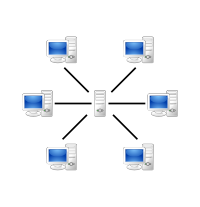CLIENT-SERVER
-> System or networking is a distributed application architecture that partitions tasks or work loads between service providers (servers) and service requesters, called clients.[1] Often clients and servers operate over a computer network on separate hardware. A server is a high-performance host that is a registering unit and shares its resources with clients. A client does not share any of its resources, but requests a server's content or service function. Clients therefore initiate communication sessions with servers which await (listen to) incoming requests.
-> Client-server describes the relationship between two computer programs in which one program, the client program, makes a service request to another, the server program. Standard networked functions such as email exchange, web access and database access, are based on the client-server model. For example, a web browser is a client program at the user computer that may access information at any web server in the world. To check your bank account from your computer, a web browser client program in your computer forwards your request to a web server program at the bank. That program may in turn forward the request to its own database client program that sends a request to a database server at another bank computer to retrieve your account balance. The balance is returned to the bank database client, which in turn serves it back to the web browser client in your personal computer, which displays the information for you.

PEER-TO-PEER SYSTEM
-> Peer-to-peer (P2P) system or networking is a method of delivering computer network services in which the participants share a portion of their own resources, such as processing power, disk storage, network bandwidth, printing facilities. Such resources are provided directly to other participants without intermediary network hosts or servers.[1] Peer-to-peer network participants are providers and consumers of network services simultaneously, which contrasts with other service models, such as traditional client-server computing.
A peer-to-peer based network:


0 comments:
Post a Comment